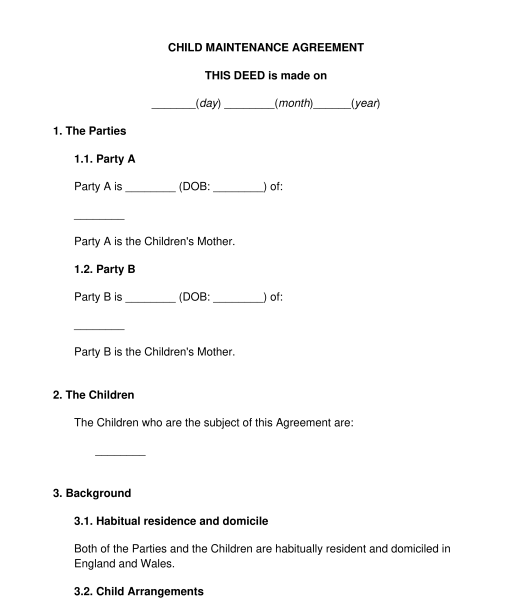 25/10/2025
25/10/2025

Answer a few questions and your document is created automatically.

Your document is ready! You will receive it in Word and PDF formats. You will be able to modify it.

 25/10/2025
25/10/2025
 Word and PDF
Word and PDF
 4 to 6 pages
4 to 6 pages
A child maintenance agreement can be used by two parents in England and Wales who are separating or have separated. The purpose of the agreement is to record how much one parent will pay to the other parent to cover the costs involved in a child's upbringing.
It is possible for parents to make a:
A child arrangements separation agreement is primarily used to define the living arrangements for the child or children, and the time (contact) they will spend with the non-resident parent.
A child maintenance agreement will set out the agreement about financial arrangements for the children. Typically, this will specify the financial contributions made by the non-resident parent.
No. It is not mandatory to have a child maintenance agreement.
If the parties can agree on the payment of child maintenance, then they may decide that it is not necessary to put this in writing.
A parent can also apply to the Child Maintenance Service (CMS) for child maintenance payments in relation to another parent. The CMS is a government body which is responsible for:
The highest amount of a non-resident parent's gross weekly income which the CMS will take into account is £3,000, so a written agreement or a court order can be helpful where the non-resident party earns over this amount.
A resident parent is the term used to describe the parent with whom a child lives.
A non-resident parent is a term used to describe the parent with whom a child does not live. A child may spend time with their non-resident parent (this is called 'contact' time).
Parental Responsibility is the legal term for the rights and responsibilities held by a parent or legal guardian of a child. A person might automatically hold Parental Responsibility, or they might acquire it via a legal process (such as a legal agreement or a court order).
The parties will need to agree on the amount of maintenance that will be paid under the agreement.
As the agreement is a formal deed of agreement, they must:
The suggested method of sharing financial information is by attaching to the agreement a completed Form E (where the parties were or have been married/civil partners) or Form E1 for all other cases.
Any parents who are separating or have separated may enter into a child maintenance agreement. This might include parents who are or have been married, civil partners or cohabiting. A party should be of sound mind when they make the agreement.
A child maintenance agreement can remain in place until a child reaches the age of 18 or until they finish full-time education, whichever is the latest.
The parties can however review and update the agreement regularly. The agreement will specify the agreed period for review.
Each party should retain copies of the signed agreement. The parties can make a mutual court application to make a family-based simple agreement into a binding consent order in the future, or they can simply refer to the agreement.
The parties should:
It is not a requirement to register a child maintenance agreement. If the parties are in dispute about child maintenance, they have the option of contacting the Child Maintenance Service.
The parties can also make a request to formalise an informal written agreement, by making an application to the Court for a court order.
The parties must have their signatures witnessed as the document will take the form of a deed. A witness should be over the age of 18, of found mind and should not be a party to the agreement.
The document will not be reviewed by a lawyer to ensure that the legal content applies to the personal situation of the parties. In order to review the particulars of any final agreement, it will be necessary to instruct a lawyer. For assistance finalising, reviewing and executing a deed, advice should be sought from a lawyer who is regulated by an approved regulator in the legal services sector. It is possible to search for a lawyer using the Law Society – find a solicitor webpage.
The parties will need to seek legal advice. The legal advisor will advise of their costs in advance.
If the parties would like to make an application to the Court for a child maintenance agreement to be converted into a legally binding court order, there will be a court fee involved.
By law, a parent has a duty to maintain their child. This is the case for all legal parents, regardless of whether they hold Parental Responsibility. It is therefore really important for parents to make proper arrangements for the payment of child support when they separate.
A child maintenance agreement should contain the following key information:
The following key legal provisions are relevant to the issue of child maintenance:
You fill out a form. The document is created before your eyes as you respond to the questions.
At the end, you receive it in Word and PDF formats. You can modify it and reuse it.
A guide to help you: Signing Documents in England and Wales
Child Maintenance Agreement - Template - Word & PDF
Country: United Kingdom